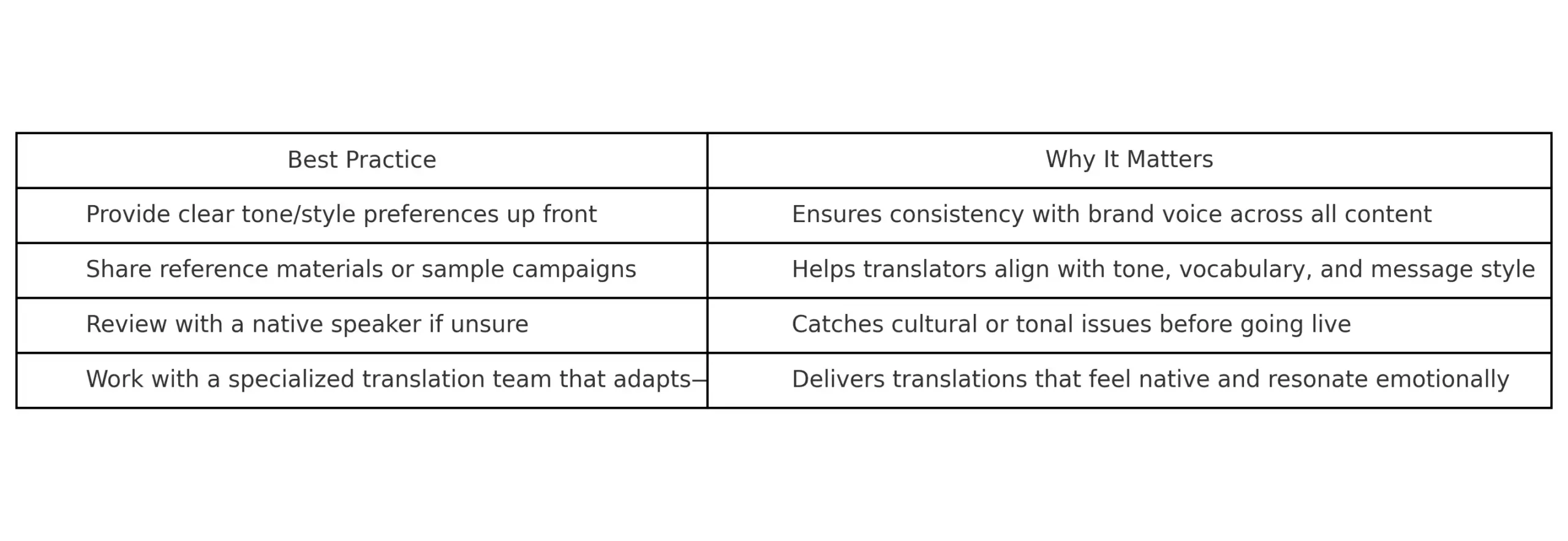Tone and style are not just “extras” in Chinese Translation — they define whether your message connects with the audience or gets lost. A technically correct translation can still fail if the tone sounds off, too formal, or culturally inappropriate. That’s why professional translators treat tone and style as critical parts of the translation process.In fact, many businesses discover that the success of their global expansion depends less on literal accuracy and more on how tone is managed within Chinese Translation projects.
❓Is Accuracy Enough?
When businesses expand into China, word choice is only half the story. In Chinese Translation, tone and style influence how your audience perceives your brand. The difference between addressing customers with 您 (nín, polite form) versus 你 (nǐ, casual form) can determine whether your message feels respectful or distant.
“You can get all the words right and still fail to get the message across.”
— Ling Zhao, Chinese copy editor
🎯 What Are Tone & Style?
Tone (语气) refers to the emotional and social register:
Is the sentence formal or casual? Respectful or direct? Encouraging or authoritative?
Style (风格) refers to broader writing traits like sentence length, vocabulary complexity, rhythm, and even the degree of poetic flair.
| Element | Example in English | Example in Chinese |
|---|---|---|
| Polite tone | “Please kindly note…” | “敬请留意…” |
| Youthful style | “Hey, check this out!” | “嘿,来看看这个!” |
| Formal business style | “We appreciate your feedback.” | “我们非常感谢您的宝贵意见。” |
📌Why Does Tone Matter More in Chinese?
When businesses expand into China, word choice is only half the story. In Chinese Translation, tone and style influence how your audience perceives your brand. The difference between addressing customers with 您 (nín, polite form) versus 你 (nǐ, casual form) can determine whether your message feels respectful or distant.
Cultural expectations also shape tone. Marketing campaigns in Mainland China may adopt a direct, energetic style, while in Taiwan the same message might use softer, more formal expressions. Recognizing these differences ensures that your translated message feels native rather than foreign.
💼Where Do Mistakes Happen?
- Marketing translations: Overly literal tone can kill a product’s vibe
- Legal or academic: Using casual style instead of formal register can undermine credibility
- User interfaces (UI): Tone inconsistency between menus and alerts confuses or frustrates users
- Customer support replies: A wrong tone feels cold or robotic
Here are real-life examples of marketing translation successes (and near-misses) involving major global brands adapting their tone and style for Chinese audiences—showing how crucial localized tone is in Chinese Translation projects.These mistakes highlight how tone consistency is central to effective Chinese Translation, especially in marketing, legal, and customer-facing materials.
🍎 Apple
Slogan in English: “The power to be your best.”
Literal translation (bad): 赋予你成为最好的力量。
— Feels abstract, clunky, and emotionally distant.
Localized version (used):
“强大,由你掌控。”
(Power. In your control.)
— Simple, powerful, mirrors Apple’s minimalist style and resonates with tech-savvy users in China.
🏀 Nike
Slogan in English: “Just Do It.”
Literal translation (bad): 只管去做。
— Feels commanding and lacks inspiration.
Localized version (used):
“活出你的伟大。”
(Live your greatness.)
— Adds aspirational, emotional weight that aligns with local storytelling culture and Nike’s brand tone.
📱 Samsung Galaxy
English feature ad: “Shoot with style.”
Literal translation (bad): 用风格拍摄。
— Sounds odd and unnatural.
Localized version (used):
“用镜头表达态度。”
(Express your attitude through the lens.)
— Sophisticated and stylish; aligns with modern Chinese consumer expectations for self-expression.
These examples show why tone is not just about words but about perception. In global campaigns, Chinese Translation done with cultural awareness ensures that brand slogans feel inspiring rather than awkward.
🍔 KFC China
Menu Campaign Tagline (literal version): “It’s finger-lickin’ good” → 好吃得吮手指
— Literal translation was once used early on but caused confusion or awkwardness.
Adapted version (used now):
“吮指回味,无法抗拒!”
(Finger-licking taste, impossible to resist!)
— Adds emotion, urgency, and mouth-watering appeal in Chinese.
💄 L’Oréal Paris
Original: “Because you’re worth it.”
Literal translation (bad): 因为你值得。
— Too blunt, lacks emotional grace.
Used in China:
“你值得拥有。”
(You’re worth having it.)
— Flows naturally, empowering, and deeply emotional—hugely popular among female consumers.
Real case:
One e-commerce client translated “Buy now to save!” as “立即购买以节省” — grammatically fine, but it felt robotic. Az-Loc adapted it to “现在下单,立省好几元!” — still accurate, but much more natural, lively, and click-worthy.
💬How Do Translators Get It Right?
Professional Chinese translators use a combination of:
- Style guides (e.g., Microsoft, Alibaba, brand-specific tone guides)
- Reference corpora like CNKI or Sketch Engine
- Glossaries + translation memory tools (for tone-consistent reuse)
- Client interviews or brand tone checklists (e.g., is the brand fun or authoritative?)
🧪Does tone differ between Simplified and Traditional Chinese?
Great question. Simplified Chinese (Mainland China) often favors a slightly more direct and efficient tone, especially in tech and business.
Traditional Chinese (Hong Kong, Taiwan) leans toward more formal, courteous phrasing—especially in public-facing and government documents.
“One tone does not fit all. Mainland and Taiwan customers may read the same sentence very differently.”
— Wendy L., TPM at Az-LocREAD MORE: English to Simplified Chinese or Traditional Chinese – How to Get Both at Lower Costs?
🧭 So how should clients ensure the right tone/style?
- Provide clear tone/style preferences up front: formal? youthful? promotional?
- Share reference materials or sample campaigns
- Review with a native speaker if unsure
- Work with a specialized translation team that adapts—not just translate
Best practices table: why tone and style matter in Chinese Translation projects.

🟨 Quick Checklist: Is Your Chinese Tone & Style On Point?
✅ Uses appropriate level of formality (您 vs 你)
✅ Matches sentence rhythm and clarity with audience expectation
✅ Avoids literal translations of idioms or slogans
✅ Sounds native when read aloud
✅ Aligns with brand voice and cultural expectations

Quick checklist designed for tone/style accuracy in Chinese Translation work.
Tone and style in Chinese Translation aren’t “extras”—they’re essential. Whether you’re trying to sell, inform, support, or inspire, tone is how your message feels. And in Chinese, how it feels often matters more than what it says.
🚀 Want translations that sound just right?
Az-Loc delivers culturally adapted, tone-perfect Chinese Translation services — for websites, campaigns, apps, or support docs.
👉 Get in touch and make your voice heard the right way in Chinese Translation projects.
